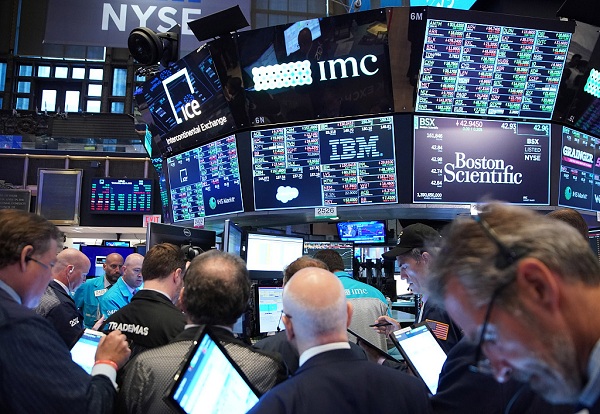NEW YORK, July 31 (Xinhua) -- The three major U.S. stock indexes fell steeply in Wednesday afternoon trading after U.S. Federal Reserve's chair said yesterday's rate cut was not the start of a new trend.

Traders work on the the floor of the NYSE at the opening bell at the New York Stock Exchange on Wall Street in New York City on Wednesday, July 31, 2019. (Photo: VCG)
Senior analysts held that Fed chair's guidance has triggered confusion and disappointment among market participants over the outlook for future rate moves, who had priced in further rate cuts later this year.
The Fed's statement has shown that it is willing to provide "additional accommodation" to support inflation and offset downside risks in the near future.
The Dow Jones Industrial Average closed down 333.75 points, or 1.23 percent, to 26,864.27. The S&P 500 slumped 32.80 points, or 1.09 percent, to 2,980.38. The Nasdaq Composite sharply slid 98.19 points, or 1.19 percent, to 8,175.42.
The U.S. central bank has finally validated market expectations on a quarter-point rate cut, announcing a trim of its benchmark interest rates by 25 basis points following a highly-anticipated two-day policy meeting.
The federal funds target range now stands at 2-2.25 percent, which became the first reduced range since December 2008, when rates were reduced close to zero during the global financial crisis.
In approving the cut, the Federal Open Market Committee (FOMC) said it will "continue to monitor the implications of incoming information for the economic outlook and will act as appropriate to sustain the expansion."
During an ensuing press conference, Fed Chairman Jerome Powell underlined "weak global growth, trade policy uncertainty, and muted inflation" that have prompted the Fed to adjust its assessment of the appropriate path of interest rates.
Yet Powell said the central bank's cut was a "mid-cycle adjustment," adding that the action is "not the beginning of a long series of rate cuts."
The remarks sent chills through the market's spine, evaporating all the gains of the three major indexes of the day and sinking the Dow by a tumble of over 470 points at one point in the afternoon sessions, which marked its worst day since May.
Powell's remarks have sent "a muddled and confusing message" on the outlook for the Fed funds target rate and the decision is "one that disappointed market participants hoping for a more clearly dovish signal," according to a report by Bank of America Merrill Lynch Global Research Wednesday.
Despite "the bumbling guidance" from Powell, the bank believed that the Fed will focus on the uncertainties in the economic outlook to "retain an easing bias in the short run," as the FOMC statement suggested it will likely provide additional accommodation in the near future to support inflation and offset downside risks.
However, the market still needs "clearer signals from the Fed before it can believe the Fed will truly act to re-calibrate policy to a more accommodative stance," the report stressed.
While investors pored through Fed's policy statement and Powell's remarks in search of more clues on a future path for easing moves, the market has been underpinned by robust corporate earnings for the second quarter.
So far, nearly 60 percent of S&P 500 companies have posted earnings. Among them, 76 percent have reported quarterly profits that beat market expectations, which help lifted stocks to fresh gains since last week, according to financial data provider FactSet.
Yet while the current economic expansion has been "the longest of the postwar era," it also has "the distinction of being the weakest," as U.S. GDP growth averaged only about half its normal rate, said Mark Haefele, global chief investment officer of leading Swiss investment bank UBS, in a report on Wednesday.
To both preserve and extend these recent gains, the senior expert held that the Fed "may well be willing to adopt an easier policy stance than static measures," and expected the Fed to "implement at most one more 25-basis-point cut and then to remain on hold through the end of 2020."


